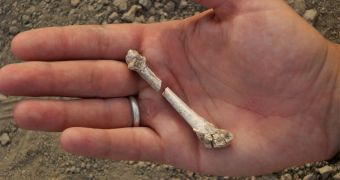For a long time, anthropologists believed that Australopithecus afarensis, an ancient hominin that lived in the Afar region of Ethiopia some 3.4 million years ago, was the only ancestor species at the time. Now, new evidence appears to indicate that it had some company.
Scientists recently discovered the Burtele foot, a fossil recovered from Eastern Africa, which seems to indicate that the group of hominins that the famous “Lucy” was a part of, was not the only one to roam Africa so long ago, during the late Pliocene.
That particular A. afarensis fossil became so well-known because it suggested that the early ancestors of modern humans had begun to walk upright at that time. However, experts could never really agree on whether her species was the only one to be capable of this form of locomotion.
Finding out more about the distribution of various hominin species in their particular geologic times is of great importance for figuring out how modern humans evolved from their earliest ancestors. The new study is detailed in the March 28 issue of the top journal Nature.
Parts of the funds needed to conduct this investigation were provided by the US National Science Foundation (NSF) Division of Behavioral and Cognitive Sciences (DBCS). “There was indeed more than one early hominin species during that time,” researcher Yohannes Haile-Selassie explains.
He holds an appointment as the head of physical anthropology at the Cleveland Museum of Natural History, and was also the lead author of the new paper. His team of anthropologists and geologists managed to discover portions of a fossilized foot that is extremely interesting.
The group says that the remains do not belong to A. afarensis, or Kenyanthropus platyops, another hominin that some researchers believe lived in Africa around the same time as A. afarensis. This left the group with no other solution than to propose the existence of a new hominin species.
“Tim White, (a member of the research team who began uncovering Lucy in 1973), argued that Kenyanthropus platyops is a Kenyan version of Australopithecus afarensis and that the subtle differences between the two could be subsumed into an intra-specific variation,” Haile-Selassie says.
The specimens originally used to propose the existence of this hominin are considered by some to be damaged, and therefore unsuited for basing an entire theory on the data they may contain. This is why many do not even believe K. platyops even existed.
But the discovery appears to confirm that at least two hominin species roamed the plains of Africa at the same time. The newly found fossil was dated to about 3.4 million years ago, which means that it was a contemporary of A. afarensis. However, the shape and form of the foot fragment was unlike that of A. Afarensis.
In fact, the study team says, the locomotor adaptations found in these remains are reminiscent of what scientists discovered in Ardipithecus ramidus, a species of old hominin that lived more than 4.4 million years ago.
“The Burtele foot differs from Australopithecus afarensis largely by possessing an opposable great toe,” Haile-Selassie explains. He adds that this implies similar walking, running and jumping characteristics for the new species and Ardipithecus ramidus.
“This partial pedal skeleton is unique in providing important evidence bearing on the functional morphology and proportions of several early hominin foot elements,” the research group writes in the Nature paper, which is entitled “A new hominin foot from Ethiopia shows multiple Pliocene bipedal adaptations.”
“We become increasingly aware of the fact that the evolutionary history of hominins is not unlike that of other groups of organisms in the potential for morphological and behavioral diversity and multiple adaptive pathways characterizing those life-forms during particular evolutionary time periods,” says Carolyn Ehardt.
She holds an appointment as a program director for NSF Biological Anthropology Division.

 14 DAY TRIAL //
14 DAY TRIAL //